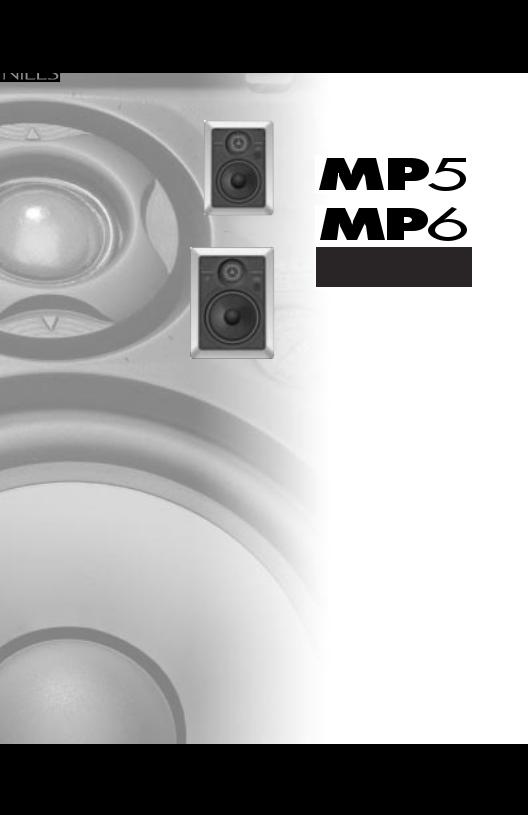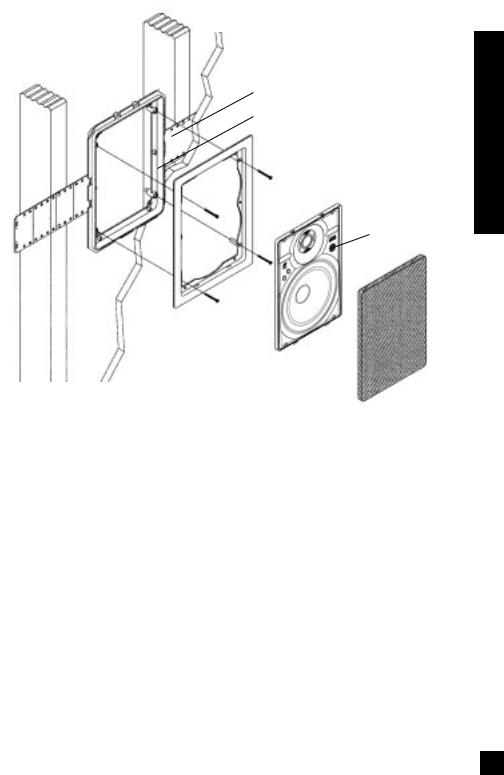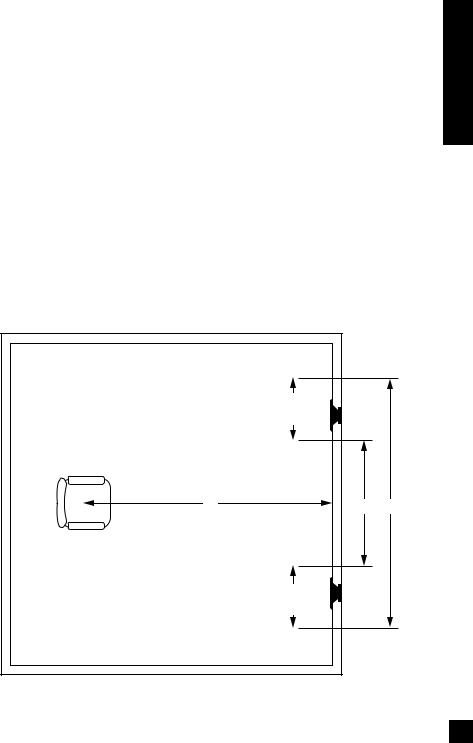Niles Audio MP6, MP5 User Manual

I N S T A L L A T I O N & O P E R A T I O N G U I D E
M O D E L S
®
B L E N D I N G H I G H F I D E L I T Y
A N D A R C H I T E C T U R E ®
Congratulations!
Thank you for choosing a Multipurpose In-Wall Loudspeaker from Niles. With proper installation and operation, you'll enjoy years of trouble-free use.
Niles manufactures the industry's most complete line of custom installation components and accessories for audio/video systems. For a free full line catalog write:
Niles, Catalog Request, P.O. Box 160818, Miami, Florida 33116-0818
TABLE OF CONTENTS
INTRODUCTION |
2 |
|
|
FEATURES AND BENEFITS |
2 |
|
|
INSTALLATION CONSIDERATIONS |
4 |
|
|
SPEAKER PLACEMENT |
6 |
|
|
INSTALLATION FUNDAMENTALS |
9 |
|
|
INSTALLATION OF BRACKETS, FRAMES AND GRILLES IN NEW CONSTRUCTION |
13 |
|
|
INSTALLATION OF BRACKETS, FRAMES AND GRILLES IN EXISTING WALLS |
15 |
|
|
INSTALLATIONOFTHE SPEAKER, SENSOR AND GRILLE INNEWOREXISTING CONSTRUCTION 16 |
|
|
|
REMOVAL OF SPEAKER AND GRILLE |
20 |
|
|
OPERATION |
20 |
|
|
SPECIFICATIONS |
21 |
|
|
WARRANTY REGISTRATION CARD |
25 |
|
|
LIMITED WARRANTY |
26 |
|
|
|
|
©2000 Niles Audio Corporation. All rights reserved. Niles, the Niles logo, Blending High Fidelity and Architecture and Systems Integration Amplifiers are registered trademarks of Niles Audio Corporation. BumpBack and MicroSensor are trademarks of Niles Audio Corporation. Kaladex is a registered trademark of DuPont Teijin Films. Dolby is a registered trademark of Dolby Laboratories Licensing Corporation. Decora is a registered trademark of Leviton Manufacturing Co. Because Niles strives to continuously improve its products, Niles reserves the right to change product specifications without notice. The technical and other information contained herein is not intended to set forth all technical and other specifications of Niles products. Additional information can be obtained on-line at www.nilesaudio.com or by calling Niles at 1-800-289-4434. Printed in Taiwan. 11/00 DS00281ATW

Introduction
The MP Multipurpose group of in-wall loudspeakers offers speakers designed for utility and flexibility. These are quality "general purpose" speakers. They function well as primary speakers in bedrooms, dens or living rooms; as main or surround speakers in home theaters;
or in large arrays in commercial applications. Their superb value makes them perfect for a wide variety of applications.
An MP5/MP6 Speaker Kit; and the corresponding Bracket Kit (5 or 6) is required to install one pair of MP5/MP6 in-wall loudspeakers in either new or existing construction.
Features and Benefits
Talc-Filled Polypropylene Woofer with Treated Foam Rubber Surround and Custom Debris Screens
The Niles MP Multipurpose series of loud- speakers employ a woofer made of vacuum formed polypropylene with talc added for stiffening. The resulting cone offers high efficiency which offers an easy load to amplifiers. Custom debris screens prevent insulation from coming in contact with the woofer.
3/4" Kaladex® Tweeter housed in a Precision Adjustment Mechanism
The MP Multipurpose series Kaladex® Tweeter employs DuPont’s latest material technology to produce a dome tweeter with exceptional frequency response and low distortion. Highs are crystal clear and extended without the harshness often associated with polycarbonate designs.
The Kaladex® tweeter is housed in a precision adjustment mechanism which permits the tweeter to be accurately positioned after installation for optimum performance without the diffraction distortion endemic to other speaker brands utilizing traditional pivoting tweeters.
Antiresonant Wave Bracing
The MP speaker’s baffle design employs specially molded ribs that increase the rigidity of the baffle and raise the resonant frequency so that less “out-of-phase” cancellation takes place. Equally important, the ribs are curved and crossed to further shift vibration modes away from low-bass canceling frequencies. This keeps bass tones rich and dynamic.
Snap-in Baffle Assembly
This proprietary Niles design enables installers to attach Niles loudspeaker assemblies to installed frames without additional hardware or tools. Niles' Snap-in design makes it easy to upgrade Niles' speakers after installation without the hassles associated with removal and re-instal- lation of traditional designs. Snap-in baffles make installation of Niles speakers baffles easier and faster than other in-wall brands.
No-Strip Speaker Terminal
Niles’ patented No-Strip terminal enables speakers to be connected without stripping the speaker wire. No-Strip terminals eliminate fumbling with wire strippers and input terminals. They are color coded and simply plug into the crossover circuit boards on the back of Niles speakers, resulting in positive in-phase connections every time.
Benefits and Features
2

Benefits and Features
BumpBack™ Woofer Magnet
Niles engineers have utilized a unique motor construction enabling far greater “throw” or voice coil excursion. This allows a high level of bass performance to be achieved.
Absolutely Flush to the Wall Appearance
The unique mounting system of the MP loudspeakers powerfully clamps the frame to the bracket, sandwiching the wall material between them. Because the clamping action is totally uniform around the frame, there are no shadows or gaps between the wall and the frame. Additionally, the Niles mounting system is carefully optimized to stiffen the surrounding drywall and prevent it from resonating. You hear only the music, not the drywall.
Easy Retrofit Installation in your Existing Home
Designed for ease of installation, the Niles mounting system makes retrofit installations simple and fast. A supplied template assures fast and accurate hole cutting. The bracket slips behind the drywall and the screws secure the bracket to the frame, sandwiching the drywall between them. The speaker baffle attaches to the frame, and the grille mounts over the speaker.
Three Stage Installation System for Remodels or New Construction
You install only the parts you need for a particular stage of construction. When the framing and wiring are finished, you install the bracket. After the drywall is up, but before the painter begins to paint, you install the frame and provide the rustproof aluminum grilles to the painter so that they can be painted to match the surroundings. Only when construction is completely finished do you put the valuable speaker in the wall. You don’t have to mask or prep
the speaker for painting, and worries about theft during the final phases of construction are never an issue!
Low Diffraction, MicroPerf™
Aluminum Grilles
MP speakers include aluminum grilles. The painted aluminum grille has hundreds of precisely sized perforations, creating an acoustically transparent grille.
Infrared Sensor Mount
The speaker baffle has a locator designed for the Niles MS-1 MicroSensor™, a miniature infrared sensor. The MS-1 installs discreetly behind the aluminum grille and therefore minimizes wall clutter in your home. When you want to control your equipment, you simply point your remote control at the speaker from up to 15 feet away.
3

Figure 1
Model HD8 Shown
New Construction Wings
Bracket
Frame
Speaker Baffle
IR Knockout
Grille
Considerations Installation
Installation Considerations
Recommended Amplifier Power
For satisfactory performance, we recom- mend an amplifier with a power rating of five to sixty watts for the MP5; and five to seventy-five watts for the MP6. Curiously, most speakers are not damaged by large amplifiers but by small amplifiers. If your system is playing loudly, a small amplifier will run out of power very quickly. When an amplifier runs out of power it creates damaging “clipping” distortion. A large amplifier will play at the same volume without distorting. See the section on operating the speakers for more information about clipping distortion.
Incorporating a Local Volume Control
In a multiroom system there is one indis- pensible device for true convenience—a local volume control. It allows you to adjust the volume of the speakers without leaving the room.
Plan to wire the system so that each pair of speakers has its own volume control built into the wall (think of a volume control as a dimmer switch for sound).
Niles makes a wide range of high performance indoor and outdoor volume controls. They are available in Standard or Decora® style cover plates (just like your light switches and dimmers). Volume controls are connected in line with the speak-
4

Considerations Installation
er, so you must connect the wire from the amplifier to the volume control and then from the volume control to the speaker.
Speaker Wire
Use 2-conductor speaker wire when con- necting MP speakers to your receiver or amplifier. For most applications, we recommend you use 16 or 18 gauge stranded wire. For wiring runs longer than 80 feet we recommend 14 gauge stranded wire. The no-strip terminals of the MP speakers will accommodate 12 to 18 gauge wire.
When you run wire inside walls, special jacketing (CL-2 or CL-3) is required to both protect the wire and for fire prevention. In some areas conduit is required. For a trouble-free installation, low voltage wire such as speaker wire must be run in accordance with the National Electrical Code and any applicable provisions of the local building code. If you are unsure of the correct installation techniques, wire jacket or type of conduit to use, consult a professional audio/video installer, your building contractor, or the local building and inspection department.
Incorporating a Remote Control
If you are planning to use a stereo system with a hand held IR remote control, consider the advantages of installing a Niles IR Repeater system. You are able to control all of the functions of your system from the room via the remote pair of speakers. Niles makes a number of IR sensors which install in the wall, in the ceiling, in cabinetry, on tabletops, or even behind the grille of your Niles MP speakers.
An IR sensor requires that a 2-conductor shielded wire (West Penn D291 or equivalent) be home run from each sensor location to the main equipment location. This wire is normally run beside the speaker wire at the same time. Typically, the sensor is placed in a location that faces your listening position. Most remote controls will have an effective line of sight range of 18 to 30 feet with any Niles sensor placed in a wall, ceiling, on a cabinet or tabletop. However, when you place a Niles MS-1 MicroSensor™ behind the perforated aluminum grille of a speaker the effective range is reduced to 9 to 15 feet.
Insulating the Wall Cavity
For best performance from your speakers fill the wall cavity behind the speaker with fiberglass insulation (e.g. R-19 unbated insulation). Try to keep the same amount of insulation for each speaker, particularly in the same room, for consistent bass response.
TECH TIP
Wire size is expressed by its AWG (American Wire Gauge) number. The lower the number, the larger the wire, i.e. twelve AWG is physically larger than fourteen AWG.
5

Speaker Placement
Placement for Critical Listening
If you like to imagine that the band or orchestra is playing in front of you as you listen to music, or you are very conscious of clarity, detail and the textures of the individual instruments, you are a critical listener.
In a home theater, the intelligibility of dialog and action reproduced by the front speakers is paramount! The position of the speakers plays a very important role in how clear the sound is and how a stereo image is created. Here are some guidelines to make the process of placement quick and easy.
Make sure the sound will not be blocked or reflected off of furniture or other objects. You should have a direct line of sight with
the front of the speaker. To determine the best position, measure the “listening” distance between the ideal listening position (your favorite chair or couch) and the wall in which you plan to install the speakers. Try to place the speakers so that they are equally distant from your listening spot and at least one half of the listening distance apart (this maintains a large pleasant stereo “image”). In home theater applications where there is a center channel you may choose to space the left and right main speakers farther apart for a “bigger than life” sound with Dolby® encoded movies and TV shows. However, for combined music and movie usage stay within the good placement zone for music. For exam- ple; if you are ten feet back from the wall, the speakers should be between five and ten feet apart (See Figure 2).
|
Speaker |
|
|
Placement |
|
|
Zone |
|
10’ |
5’ |
10’ |
|
||
|
Speaker |
|
|
Placement |
|
|
Zone |
|
Figure 2 |
|
|
Placement Speaker
6

Placement Speaker
The Boundary Effect
Corners can affect the bass response of the speaker powerfully! This is called the boundary effect. You will emphasize particular bass frequencies and cancel out other bass frequencies when you place speakers close to the wall/ceiling boundary or a corner wall boundary. This can make the speaker sound excessively boomy and inaccurate to some listeners, while to others it just seems like more bass sound. A good rule of thumb is if you always listen to your current pair of speakers with the bass turned up, you’ll enjoy corner placement. If you keep your tone controls at neutral, try to keep the speakers at least two or three feet from the boundaries of the room.
Placement for Varying Listening Positions
If you want the freedom to sit anywhere in a room facing any direction, and/or find that you prefer the “all around you” sound of some car stereos to a conventional “sound stage” facing you, consider the speaker placement techniques professional installers use in restaurants and bars. They place speakers in an array around the listening area, so that the music is always surrounding you, regardless of the direction you face.
The rule of thumb is to add one pair of speakers for every 100 to 200 square feet of listening area. Curiously, this is not so that you can play the music louder, but so that you can play it softer! When you have only one pair of speakers in a large room you will notice that when the sound is perfect in one part of the room, it is too loud near the speakers. By placing more than one pair in the room you will avoid these “hot spots” of loud sound and you will create more sonic ambiance while maintaining clarity and a rich sound everywhere.
You can make listener position still less critical by using mono rather than stereo. This can be difficult to achieve with normal stereo amplifiers. However, Niles manufactures Systems Integration Amplifiers which enable one room to be wired in stereo while other rooms are wired in mono! Consult your local Niles dealer for more information.
In smaller rooms or rooms that are infrequently used, you typically can’t justify the expense of more than two speakers. Try to bracket the room with the two speakers. Diagonal placement is a very effective way to stretch the coverage pattern of two speakers. You can also compromise between direct sound (for detail and clarity) and reflected sound (the ambient or “all around you” effect). By trying to place the speakers so that they create as much reflected sound as possible you emphasize the ambient effect. They can be up high in the wall or even down low at power outlet height , in the ceiling, near corners, or directed at reflective objects and walls. The more reflected sound there is in the room the stronger the ambient effect at low volumes. You should use moderation, however, otherwise the compromise becomes too one sided and at high volumes the sound will be blurred and less distinct.
Placement for Rear Home Theater Applications
In a home theater, the goal is to reproduce the experience of a great movie theater in our homes. The biggest difference between the two is the rear or surround speaker array in a commercial theater. Here, it is not uncommon to see twenty or thirty speakers around the audience. This huge array of speakers assures that you will feel completely surrounded by the ambient soundtrack of the movie. Film makers try to use the “surround”
7

soundtrack to envelope you in the envi- ronment on screen. They will place background music, rain sounds, traffic noise, etc. on the “surround” soundtrack. In a home with a single pair of speakers it is easy for the jungle sounds to sound like they are “in the middle of your head” just like headphones!
A single pair of MP loudspeakers, properly placed, can create a very convincing simulation of an array of speakers. If you place them near a hard reflecting surface you can make one pair of speakers sound like several. Create as many reflections as possible by mounting the speaker up high in the wall so that the ceiling will act as a powerful reflector. If you place the speakers near a corner, wash the sound down a wall from a ceiling location, or mount the speakers as far away as you can from the listening area, more reflections will occur. However, all of these placement techniques require that you work your surround sound amplifier channels harder. If the surround sound system you are using has a small five or ten watt amplifier for
the rear speakers, stay within five to eight feet of the listening location. If you are using a 25 to 50 watt amplifier you can mount the speakers 10 to 15 feet away from the listening location and still achieve reasonably high volume levels.
Of course, the best way to emulate the sound of multiple speakers is to use multiple speakers. In large or unusually shaped rooms this might be the only way to achieve a good effect. If you like to listen to music surround modes which emulate concert hall acoustics, more than two surround speakers will prove extraordinarily effective. With Niles MP loudspeakers it is easy to add another pair without affecting the decor of the room. However, you will need to use a much more powerful amplifier than that which is built into a typical surround sound receiver or amplifier. Niles makes a number of Systems Integration Amplifiers® with proprietary features that make them uniquely suited to enhance a good surround sound system. Consult your Niles dealer for more information.
Placement Speaker
8
